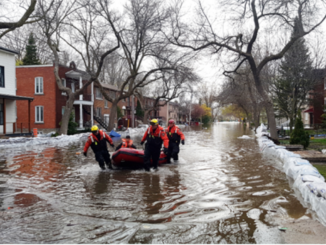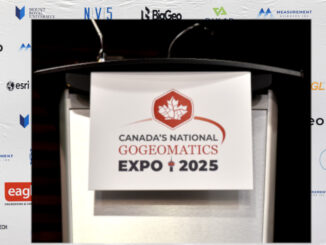
In a dynamic and informative session at LiDAR CANEX 2024, Alex Hill-Stosky shed light on the groundbreaking initiative known as the CanSLAM Circuit, which he founded alongside Carina Butterworth of the Southern Alberta Institute of Technology.
What is SLAM?
Just to start with the basics, SLAM, or simultaneous localization and mapping, is a technology that scans its surroundings and determines location in real-time without relying on GPS. First introduced in a 1995 paper, SLAM tackles the challenge of identifying one’s location while simultaneously creating a map of the environment. It utilizes advanced algorithms and tools like LiDAR and 360° cameras to accomplish both tasks concurrently. LiDAR emits laser pulses to measure the time it takes for light to reflect off objects, aiding in mapping and localization simultaneously.
They are diverse instruments that can be affixed to a wide range of collection platforms. From vehicles, backpacks, and robots to really “anything that moves” as Alex puts it. Their flexibility and mobility allow for the creation of accurate 3D maps in many different industries such as urban planning, construction, environmental analysis, mining and many more. They provide improved decision-making capabilities, high-fidelity site reporting, and will be integral in the implementation of digital twins as that market keeps rapidly expanding.

Issues facing the SLAM industry
Alex also addressed many of the industry’s challenges when it comes to SLAM systems, and it is worth outlining them here:
- SLAMs can be similar, yet unique
- Systems can have design variation/adaptation
- Dozens of companies, dozens of models
- Performance metric non-standardized
- Sample data difficult without engagement
- Coordinating ‘demo’ trials time consuming
- Decentralized information = inefficient
- Google, CoPilot searches ineffective or inefficient
- Extraction & Rendering: semi-auto, repetitive, imprecise
The plan to solve these issues
These issues result in making it a quite difficult decision when it comes to picking the SLAM unit that most suits your needs as a business or for different projects. This issue is what led to the creation of the CanSLAM circuit, which, as emphasized, is designed to be a resource, and not a (direct) competition. Through the circuit, Alex hopes to get as many people and industries (not just geospatial) introduced to these machines and their applications as possible. The six main goals of the circuit are:
- Introduce Canadian industry to SLAM manufacturers
- Encourage discussion of adoption and application
- Introduce considerations of adoption
- Provide free base datasets for consideration
- Bring SLAM manufacturers together
- Promote downstream A.I. integration
So how does it work?
In preparing for the CanSLAM Circuit, a lot of work goes into getting in ready. Starting with a meeting to assess the needs of the community and then design the program to best fit these needs. Building this program out is followed by sending invites to the vendors that the committee hopes will attend. On the day of the event the data is collected by all the participants, which is then evaluated against the decided upon criteria. This evaluation is then reported and promoted back to the community. Alex also confirmed that the results will be first announced at the GoGeomatics Expo in Calgary taking placing October 28-30, 2024.
The evaluation of the data looks at many different criteria that they feel is important to the industry and users of these SLAM devices. This includes price, which last year was evaluated as cost for one year, but this year they are considering looking at making a change to cost for somewhere between 3 and 5 years. The next is time spent in the field using each device for the data collection, post-processing time from start of upload to completed export. Post-processing location looked at cloud-based and local-drive-based solutions. Local was weighted strongly in some cases due to security considerations. Point cloud density and confidence were also important factors that were considered in the competition, as obviously you want to have enough data and be confident in it when you are considering a SLAM system. This was reliant on the controls provided, which were further criteria that were considered. Lastly, the visual interface of each unit was an important consideration with a wide range of results. Older machines often lacked any sort of screen for feedback and required a lot of trust in the process that you were collecting good data, whereas some newer machines showed you feedback right on the system itself, and how well this worked was part of the detailed evaluation.
Last year’s event
The site for the CanSLAM Circuit was picked with a lot of considerations in mind, including how it could demonstrate the above criteria. Some other considerations that led to the selection of the Telus Conference Centre in Calgary were that it provided a high traffic, public thoroughfare. This meant decorative complexity, no permission to shut down or divert traffic, a high potential for change in the environment, and an ability to be visited by anyone as a public access site. Many of these factors are dealt with by geospatial industry professionals daily as they go about their business and so it presented a real-world scenario for the testing ground. There was plenty of plane variation in the environment as well as multi-textured floors walls and ceilings, factors many BIM attendees were interested in. The elevation differences in the building provided a good test for many of the systems, including scanning and incorporating the pedestrian walkway. A building of this magnitude also provided a feature-rich environment with exposed joists, ducts and structural supports, as well as service assets and waste management locations. The art fixtures and furniture found in the conference centre provided the “cherry on top”.

Looking to the future
After reflection on the event, CanSLAM feels that the five key impacts they had on the industry were:
- Providing a manufacturer-agnostic nexus for SLAM and Mobile Mapping system introduction.
- Being a learning and selection resource.
- Creating common dataset for A.I. data training and integration.
- Emphasizing the criticality of control to SLAM students and users.
- Creating an emerging workforce more adept at rapid data collection, consolidation, and extraction.
After a very successful 2023 CanSLAM circuit, Alex and Carina feel like they are only just getting started. We think this is a great initiative that will lead to a strong SLAM community within Canada and are proud to host them at the GoGeomatics Expo. Providing a forum for this research and education, as well as a testing ground for the systems is something the whole community will benefit from. Make sure to save the date! This year’s SLAM Scan-Off will be happening in Calgary at the GoGeomatics Expo that takes place October 28-30, 2024.






Be the first to comment